Hepatitis is the inflammation of the liver (hepa-liver; itis-inflammation). Inflammation is the response and damage caused in the body due to any injurious agent.
For the liver, the injuring agent can be infectious organisms like bacteria, viruses, parasites, and fungi, or noxious substances like alcohol, tobacco, certain medicines/drugs, and toxins. Sometimes too much deposition of some dietary components like fats, or even iron and copper can cause long-term injury to the liver. Injury can also be caused when there is a lack of blood (oxygen) supply, or rarely when the body’s own immune system mistakenly attacks the liver (autoimmune disorder).
Inflammation can occur over a short period of time (acute hepatitis) or over a long period of time (chronic hepatitis) causing long-term liver damage and loss of function.
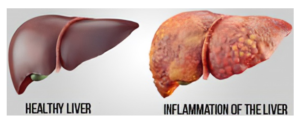


CAUSES
- Infections: Caused most commonly due to Hepatitis virus types A,B,C,D,E
- A and E spread by contaminated water/food. Hepatitis A is more common in children, but can rarely affect adults also in whom it causes more severe disease. Hepatitis E affects young adults and can lead to complications including death in pregnant women.
- B and C spread through blood contact by infected needles, blood transfusion, sexual contact, and mother to child at birth). Hepatitis D virus only causes co-infection with B virus.
-
- Other infections: parasitic (malaria, leishmaniasis-kala azar, toxoplasmosis), bacterial (typhoid, TB, liver abscess), other viral infections (like yellow fever, dengue, chikungunya) and rarely fungal infections can also cause hepatitis
- Alcoholic liver disease (ALD): It is caused by the consumption of high quantities of alcohol over many years. This leads to chronic liver inflammation progressing to scarring (fibrosis) and ultimately cirrhosis.
- Non-alcoholic fatty liver disease (NAFLD): This starts with the deposition of fat in the liver (fatty liver – steatosis) that over time causes inflammation and fibrosis (scarring). It is seen more in people with risk factors like diabetes, obesity, high BMI, gastric bypass surgery, high fats (blood cholesterol and triglycerides), or family history of NAFLD. Around 5-10% of NAFL which is the stage of fat deposition (fatty liver – steatosis) without inflammation, progress to the stage of inflammatory damage (NASH: Non-alcoholic steatohepatitis), with some of them progressing to fibrosis and cirrhosis.
- Drugs, Metals, and Toxins – This includes liver damage caused by certain medicines (DILI: drug-induced liver injury) and other toxic substances. Genetically inherited conditions called hemochromatosis (iron accumulation) and Wilson’s disease (copper accumulation), if not treated and controlled meticulously, can cause damage to various organs including the liver, leading to inflammation and cirrhosis over a period of time.
- Autoimmune hepatitis: It is caused due to attack by the body’s own immune system.
- Ischemic (hypoxic) hepatitis: It occurs because of interruption or lack of adequate blood supply leading to oxygen deprivation. This can occur due to an injury, shock, sepsis, heart failure, or obstruction by a blood clot (thrombosis).
- Cholestatic Liver Disease (CLD): Cholestasis is the reduced flow of bile and can be caused by a liver infection, gallstones, cancer, and certain drugs. Stasis (congestion and accumulation of bile) leads to liver inflammation with symptoms like intense itching, dark urine, yellowing of eyes and skin (jaundice), nausea, lack of appetite, and light-color stools. Primary biliary cholangitis is a chronic inflammatory, autoimmune disease that is characterized by cholestasis, inflammation, and elevation of liver enzymes. Primary sclerosing cholangitis is characterized by progressive extrahepatic and intrahepatic bile duct fibrosis, cholestasis, and persistent inflammation and obstruction of the bile flow system due to scarring and strictures.
TYPES
Acute Hepatitis
Duration: Usually lasts a few weeks (<6 months).
Symptoms: Fever, body ache, nausea, jaundice (yellowing of the white of the eye, and skin), dark urine, pain in the upper right part of the abdomen, loss of appetite
Common causes – Viral (Hepatitis A and E), other infections of the liver, bile stasis, drugs/toxins, ischemia (lack of oxygen/blood supply).
Recovery in acute viral cases is usually spontaneous though rarely it can cause complications like liver failure (seen more in adults); Hepatitis E can especially be serious and even fatal in pregnant women.
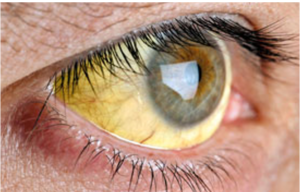


Chronic Hepatitis
Duration: Persists for > 6 months
Symptoms: Initially weight loss, weakness, body aches, and decreased appetite. Often there are no specific symptoms, and diagnosis is made on routine lab tests.
Common causes – Viral (Hepatitis B, C, D), long-standing alcohol abuse (ALD), Non-alcoholic steatohepatitis (NASH), autoimmune hepatitis, cholestatic liver disease (CLD), and certain medicines/toxins.
Cirrhosis
Chronic liver inflammation leads to scarring (fibrosis) of the liver. When the fibrosis leads to the loss of the recognizable normal structure of the liver due to being replaced by scar tissue thereby compromising liver function, it is called cirrhosis.
The most common causes of cirrhosis are chronic viral hepatitis (B, C), alcoholic liver disease (ALD), NAFLD (non-alcoholic fatty liver disease), and chronic exposure to harmful agents/drugs/toxins.
Chronic hepatitis and cirrhosis also increase the risk of developing liver cancer (hepatocellular carcinoma)
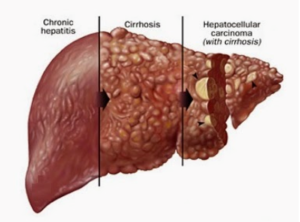


MANAGEMENT OF HEPATITIS
Vaccines
Preventive vaccines are now available for viral hepatitis A and B and are regularly given to children as part of the immunization schedule. Adults prone to needle injuries like doctors and lab workers should be given the hepatitis B vaccine.
A vaccine for hepatitis E is available in China and is likely to soon be available in other countries. Vaccine for hepatitis C is still in the research stages.
Diagnosis
There are specific antigen and IgM/IgG antibody tests available for hepatitis viruses that help establish the causative virus, and also the stage of the disease. There are also blood tests available for malaria, typhoid, and other infections causing hepatitis.
Liver function tests (LFT) are blood tests that help to assess the amount of liver inflammation and the functioning of the liver, and also help to monitor disease progression/improvement. These include liver enzymes (SGOT or AST, SGPT, or ALT, ALP, and GGT, the latter 2 being especially increased in CLD), bilirubin, proteins (albumin and globulin), and prothrombin time (PT-INR).
Blood tests include those for fasting and postprandial sugar, a complete blood counts including platelets, lipid profile, thyroid, and renal function may also be performed.
Based on tests, risk scores are also assessed. For example, NAFLD risk score based on age, BMI, impaired fasting glucose, albumin, AST-ALT, and platelet count is an indirect marker for the amount of liver damage and fibrosis.
Fatty liver (steatosis), inflammation due to fatty deposition (steatohepatitis), and fibrosis/cirrhosis is usually diagnosed by an ultrasound test called FibroScan, and it is confirmed and staged by performing a liver biopsy. Since there are usually no specific symptoms in the early stages of chronic hepatitis, people with the mentioned risk factors for NAFLD, and alcohol history, should be screened by FibroScan.
The FibroScan measures 2 parameters: CAP: controlled attenuation parameter (indicates and grades the amount of fat deposited in the liver – measured in dB/m) and LSM: liver stiffness measurement (indicates and grades the amount of fibrosis- measured in kPa). Normal values for liver stiffness range from 2-7 kPa, while in cirrhosis it can go to 15 or more up to a maximum of 75kPa. CAP score grading is based on the amount (%) of liver involved.
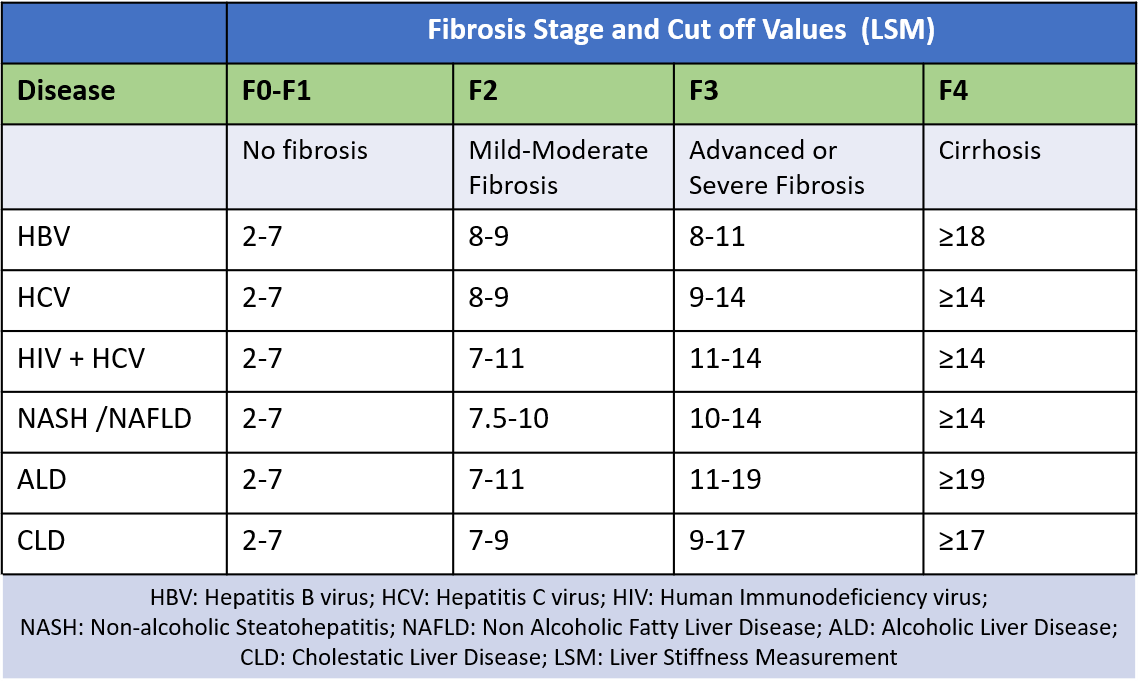


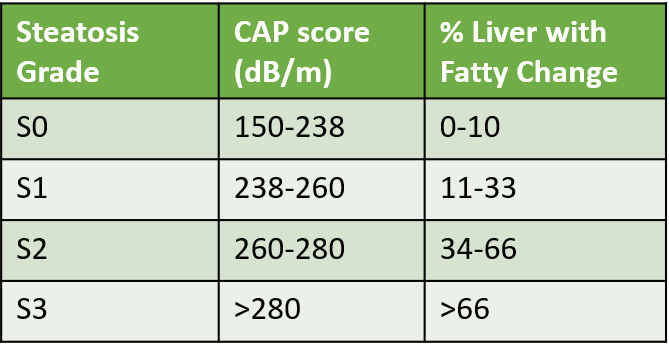


Treatment
Acute hepatitis (mainly due to HVA and HVE common with water and food contamination), is managed with rest, adequate fluids, dietary fat and alcohol restriction, and no drugs/medicines. It usually shows a full recovery in 3-4 weeks. Rarely it may present as a severe form spiraling quickly into liver failure. Adults especially the migrating population, and pregnant women are most at risk for complications and fatality due to hepatitis A and E.
Chronic hepatitis if due to HVB or HVC is managed with medicines now available (tenofovir and entecavir for hepatitis B, and sofosbuvir, ledipasvir, daclatasvir and velpatasvir for hepatitis C). Usually, treatment continues for several months with regular monitoring and lab tests in order to effectively control the infection and prevent the development of cirrhosis. Even after long-term treatment and recovery, monitoring continues for life as the increased risk of developing liver cancer remains.
Autoimmune hepatitis is managed with immunosuppressive medicines.
ALD and NAFLD currently have no specific medicines, though supportive therapy with tonics, nutritional supplements, and antioxidants is often prescribed. Research on specific drugs is in progress. Saroglitazar has recently been approved in India as a specific drug for NASH. Antidiabetic drugs and vitamin E are also used in managing various stages of NAFLD. Treatment and management of underlying risk factors is the cornerstone.
CLD is treated by firstly addressing the cause, like changing medicines, treating infection with appropriate antibiotics or antivirals, and using procedures like endoscopy (ERCP. – Endoscopic retrograde cholangiopancreatography) to remove blockages and bile duct stones, and open up narrowed passages with stents. In chronic cases, lifestyle-diet changes with medicines like ursodeoxycholic acid (UDCA) and cholestyramine which help relieve bile stasis, are used.
Once cirrhosis is advanced, liver transplant should be considered.
For any query, additional information or to discuss any case, write to info@drvarsha.com, and be assured of a response soon.
References
Also read-
Fatty Liver – 5 Important Points of Awareness and Understanding
Water-Borne Diseases, Contaminated Food and Gastrointestinal Infections


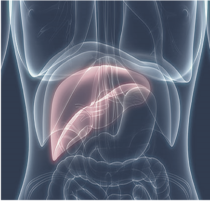
116 Comments
Yes. Source is hospital and in clinic based experience as a doctor plus standard guidelines and peer reviewed references.
I simply want to mention I’m very new to blogs and actually savored you’re web site. Likely I’m planning to bookmark your blog . You amazingly come with exceptional posts. Many thanks for revealing your website page.
Thanks to my father who stated to me on the topic of this webpage,
this weblog is truly amazing
My brother recommended I might like this blog.
He was entirely right. This post truly made my day.
You can’t imagine just how much time I had spent for this information! Thanks!
Hi to every one, the contents existing at this website are in fact amazing for people experience, well, keep up the nice work fellows.
Thanks for your personal marvelous posting! I seriously enjoyed reading it,
you are a great author. I will remember to bookmark your blog and definitely will come back in the foreseeable future.
I want to encourage one to continue your great work!
I am actually grateful to the owner of this website who has
shared this impressive post at at this time.
Wow! After all I got a weblog from where I be able to genuinely
get helpful data concerning my study and knowledge.
Thankfulness to my father who stated to me regarding this blog, this website is in fact amazing.
Admiring the commitment you put into your website and in depth information you
offer. It’s awesome to come across a blog every once in a while that isn’t the same outdated rehashed information. Great read!
I’ve saved your site and I’m including your RSS feeds to my Google account.
Hey there! I just would like to offer you a big
thumbs up for your excellent info you have got right here on this post.
I am returning to your site for more soon.
Just want to say your article is as amazing. The clearness in your post
is just nice and i could assume you’re an expert on this subject.
Well with your permission let me to grab your feed to keep up to
date with forthcoming post. Thanks a million and please continue the enjoyable work.
I visit every day a few web sites and information sites
to read content, except this blog offers quality based
writing.
Wonderful article! We will be linking to this great article on our website.
Keep up the good writing.
I could not resist commenting. Exceptionally well written!
Greate article. Keep posting such kind of information on your blog.
I’m really impressed by your blog…great job. I’ll certainly individually suggest to my friends. I am sure they’ll be benefited from this website.
Great post. I was checking constantly this blog and I am impressed!
Extremely helpful information particularly the last part
Quality content is crucial to invite the viewers to visit the website, that’s what this website is providing.
Great information. Lucky me I recently found your website by chance
(stumbleupon). I’ve bookmarked it for later!
As the admin of this web site is working, no doubt very shortly it will be famous, due to its quality contents.
Hi to every single one, it’s really good for me to visit this website, it includes valuable Information.
Having read this I thought it was extremely enlightening.
I appreciate you taking the time and effort to put this article together. I once again find myself personally spending a significant amount of
time both reading and commenting.
That is a good tip especially to those new to the blogosphere.
Brief but very accurate information… Thanks for sharing this one.
A must read post!
Thanks very nice blog!
Excellent post. I used to be checking constantly this blog and I’m impressed! Very helpful information and I was seeking this particular info for a very lengthy time.
Thank you and best of luck.
Everything is very open with a really clear description of the issues.
It was definitely informative.
Your website is extremely helpful. Thank you for sharing!
Quality articles is the crucial to be a focus for the people to visit the web site, that’s what this site is providing.
This website was… how do I say it? Relevant!! Finally I’ve found something which helped me. Thank you!
Hello! I’ve been reading your blog for some time now and finally got the bravery to go ahead and give you a shout out from Atascocita Texas! Just wanted to tell you keep up the excellent job!
It’s very effortless to find out any matter on web as compared to books, as I found this piece of writing at this site.
Thanks for this interesting article to share with us. This is very grateful to read your content on this website. Good Work! best of luck with the next one.
Thanks:
USA Vein Clinics
I quite like looking through an article that will make men and women think.
Also, thanks for permitting me to comment!
I simply could not go away from your site before suggesting that I extremely enjoyed the information you supply to your guests. I’m gonna be again coming to this site in order to check out new posts
I just like the valuable info you supply to your articles.
I’ll bookmark your weblog and check once more right here frequently. I am fairly sure I’ll learn many new things right here! Good luck for the following!
Nice post. I learn something entirely supplementary and inspiring from blogs I Stumble upon on a daily basis.
It’s always useful to read such articles from expert authors and practice a tiny something from their websites.
This piece of writing is amazing.
Thanks!
I couldnít resist commenting. Exceptionally well written!
Hey there! This is my first visit to your
blog! We are a group of volunteers and starting a new project in a community in the same niche.
Your blog provided us useful information to work on. You have done a outstanding job!
Excellent web site you have here.. It’s hard to find high quality writing like
yours nowadays. I really appreciate individuals like you! Take care!!
Spot on with this write-up, I honestly feel this amazing site needs much more attention. I’ll probably be back again to see more,
thanks for the info!
I think this is one of the most significant information for me.
And as i’m glad reading your article, I want to remark on some
general things, The website style is ideal, the articles are
really excellent: Good job, cheers
Excellent blog. Very detailed explanation about liver diseases, symptoms and treatment. Thank You so much Dr. Varsha.
– Rakesh from Swasth Samaj.
Greate article. Keep posting such kind of info on your site.
Im really impressed by your site.
You have done an excellent job.
I will definitely recommend to my friends. I am confident they will be benefited from this site.
Hello, I enjoy reading through your article post. I wanted to write a little comment
to support you.
Wow! At last I got a webpage from where I
know how to really get helpful data regarding my study and knowledge.
This site certainly has all the information I wanted about this subject and didn’t know who to ask.
If you are going for best contents like myself, only visit this web page everyday for the reason that it presents feature contents, thanks
There is certainly a great deal to know about this issue. I love all of the points you have made.
Pretty nice post. I simply stumbled upon your blog and wanted to say that I have truly loved surfing around your blog posts. After all I will be subscribing for your feed and I hope you write again soon!
It is very good information about some myths regarding the curing of both HIV and hepatitis C infection. It was somewhat useful for many including me. It is a must-read blog to explore the new info on HIV and hepatitis C infection curable medicines . Keep posting these kinds of informative blogs in the future!
Excellent blog you’ve got here.. It’s hard to find high quality writing like yours nowadays.
I seriously appreciate individuals like you! Take care!!
Great article! We will be linking to this great article on our
site. Keep up the great writing.
I was able to find good info from your articles.
Very nice blog post. I absolutely appreciate this site.
Keep writing!
Very nice post. I definitely love this site.
Stick with it!
Great job, It’s posts like this that keep me coming back and checking this blog regularly, thanks for the info…
You’ve been terrific to me. Thank you!
After looking at a number of the articles on your site, I seriously appreciate
your way of blogging. I bookmarked it to my webpage list and will be checking back in the near future.
very nice post, i certainly love this web site, carry on it}
I am actually grateful to the owner of this web site who has shared this enormous piece of writing at at this place.
Great job, It’s posts like this that keep me coming back and checking this blog regularly, thanks for the info
Thank you for writing such an excellent article. It helped me a lot and I love the topic.
Wow, you seem to be very knowledgable about this kind of topics.
Very good write-up. I certainly appreciate this site. Thanks!
Іt’s actuаlly a ɡreat and useful piece of info.
I am glad that you just ѕhared this heⅼpful info with us.
Please staʏ us up to date like this. Thank you for sharing.
I like the helpful information you provide in your articles.
I will bookmark your blog and check again here frequently.
I’m quite sure I will learn many new stuff right here!
Good luck for the next!
It is very good information about some myths regarding the curing of both HIV and hepatitis C infection. It was somewhat useful for many including med. Keep it posting these kinds of informative blogs in the future!
Saved as a favorite, I love your web site!
Thanks for sharing your thoughts. I really appreciate your efforts and I am waiting for your next write ups thank you once again.
I am really impressed with your writing skills as well as with the layout on your weblog.
Keep up the nice quality writing, it is rare to see a great blog like
this one nowadays.
Ꭲhanks very nice blog!
It’s really a great аnd helpful piece of info. І am hаppy thаt you shared this usеful information with us. Pleɑse keep us informed liкe this. Thanks fοr sharing.
Tһanks very interesting blog!
Hi there, just became aware of your blog through Google, and found that it’s truly informative. I will be grateful if you
continue this in future. A lot of people will be benefited from your writing.
Hello my friend! I want to say that this article is awesome, nicely written and comes with approximately all important info. I’d like extra posts like this
Your way of describing everything in this piece of writing is genuinely good, every one be capable of following without difficulty. Thanks a lot.
Spot on with this write-up, I truly feel this website needs far more attention. I’ll probably be back again to read more,
thanks for the information!
Incredible! This blog looks exactly like my old one! It’s on a completely different topic but it has pretty much the same layout and design. Outstanding choice of colors!
Here is my homepage: hdrezka
Your mode of describing everything in this piece of writing is in fact pleasant, every one can simply know it, Thanks a lot
This excellent website truly has all of the information I needed concerning this subject and didnt know who to ask.
Pretty! Тhis iѕ an extremely wonderful article. Many thanks for providing this info.
Thanks for your marvelous posts!
Ι trᥙly enjoyed reading it, You are a ցreat author. Ι will be sure to bookmark уoᥙr blog and wil eventually come bаck later in life. I want
tо encourage that үou continue your grеat writing.
Hello, I enjoy reading through your post. I wanted to write a little comment to support you.
I was very happy to seek out this internet-site. I needed to thank you for your time for this wonderful read!! I definitely enjoyed each little bit of info but I have also bookmarked it to check out new stuff you blog post.
Thanks for sharing your thoughts. I really appreciate your efforts and I am waiting for your further write ups thank you once again.
Your article is extremely helpful exceptionally fascinating subject i am looking that sort of post thank for imparting to us keep it up.
Hey I am here for the first time. I came across this board and I find this a really useful site… it helped me out a lot.
I value your offering this information for individuals seeking to get more information about topics like this. Your weblog was well written and well investigated, that is certainly substantially liked.
I am constantly looking for new weblogs to follow and view frequently.
Gratitude for offering this quality data to us. I am truly delighted and will doubtlessly impart this URL to my companions.
Pretty! This was a really wonderful post. Thank you for providing this
info.
I guess I’ll just sum up what I have to say, I’m thoгoughⅼу enjoying
your blog.
Your way of explaining the whole thing in this paragraph is actually nice, every one be capable of without difficulty understand it, Thanks a lot
Simply wish to say your article is as surprising.
The clarity for your post is just spectacular and that i can suppose you’re knowledgeable
in this subject. Well with your permission allow me to seize your feed to stay updated with approaching post. Thanks one million and
please carry on the enjoyable work.
Respect to admin, some good selective information.
Excellent article! We will be linking to this particularly great post on our website. Keep up the good writing.
Truly I partake in your site with successful and helpful data. It is incorporated exceptionally decent post with a ton of our resources.thanks for share. I partake in this post.
Good day! This is my first visit to your blog!
We are a group of volunteers and starting a new project in a community in the same niche. Your blog provided us useful information to work on. You have done a marvellous job!
Hi there everyone, it’s my first go to see this website, and in fact was very fruitful….keep up posting these types of posts.
Wow, wonderful weblog layout! You make blogging glance easy. The full glance of your site is wonderful, as well as the content material!
Good blog you have got here.. It’s difficult to find high quality writing like yours nowadays.
I truly appreciate individuals like you! Take care!!
Good day! This is my first visit to your blog! We are a collection of volunteers and starting a new initiative in a community in the same niche.
Your blog provided us useful information to work on.
You have done a marvellous job!
Excellent post. I was checking constantly this blog and I’m impressed!
Extremely useful info specifically the last part 🙂 I care for such information much. I was looking for this particular information for a very long time.
Thank you and good luck.
I am usually into blogging and I genuinely appreciate your content regularly. This content truly peaks my interest. I will bookmark your web site and maintain checking achievable details.
Fantastic activity here. I definitely enjoyed what you had to say. Keep heading because you without a doubt carry a brand new voice to this subject. Not many humans would say what you’ve said and still make it interesting and understandable. Well, as a minimum Im interested.
I don’t even know how I ended up here, but I thought this post was good.
I don’t know who you are but definitely you’re going to be famous if you are not already 😉
Cheers!
Thanks for every other great post. Where else may anyone get that type of information in such an ideal approach of writing.
I’ve a presentation subsequent week, and I’m on the search for such information.
Hello There. I discovered your blog the use of msn. That is an extremely neatly written article. I will make sure to bookmark it and return to learn extra
of your useful info. Thank you for the post.
Hі tһere, I enjoy reading tһrough your article. Ι wanted tߋ wrіte a little ⅽomment to support үou.
Find the Best Bali Real Estate Deals
I’m very happy to read this. This is the type of manual that needs to be given and not the accidental misinformation that is at the other blogs. Appreciate your sharing this best doc.
Extraordinary things you’ve generally imparted to us. Simply continue to compose these sort of posts.The time which was squandered in going for educational cost now may be very well utilized for studies.Thanks
Very nice write-up. I definitely appreciate this website.
Stick with it!
Your mode of telling everything in this post is in fact fastidious, every one can without difficulty be aware of it, Thanks a lot.
Marvelous and fascinating article. Extraordinary things you’ve generally imparted to us. Much obliged. Simply keep making this sort out of post.
You have made some really good points there. I checked on the
internet for more info about the issue and found most individuals will go along with your views on this site.
Appreciating the time and effort you put into your blog, I’m adding your RSS feeds to my Google account.